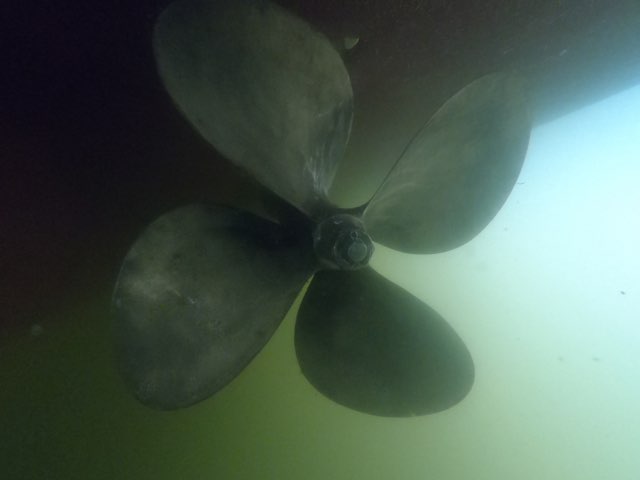
Out of Balance
Share
Even a "slightly" out of balance boat propeller can cause a surprising amount of damage and negatively impact your boating experience. Think of it like a tire on your car that's slightly out of balance – at low speeds, you might not notice much, but as you go faster, the vibration becomes more pronounced and can lead to serious issues over time.
Here's a breakdown of the dangers:
1. Vibration and Discomfort
-
Immediate Effect: The most noticeable sign of an unbalanced propeller is vibration. Even a slight imbalance will create an oscillating force as the prop spins, causing the boat to shake. This can range from a subtle hum to a severe, uncomfortable shudder throughout the hull.
-
Reduced Enjoyment: A vibrating boat makes for a less enjoyable ride for everyone on board. It can be annoying, fatiguing, and simply takes away from the pleasure of being on the water.
2. Accelerated Wear and Tear on Drivetrain Components
This is where the real danger lies, as vibrations can cause significant damage to expensive parts:
-
Propeller Shaft: Constant vibration puts immense stress on the propeller shaft. Over time, this can lead to bending, cracking, or even snapping of the shaft, which would be a catastrophic failure in the middle of the water.
-
Shaft Seals: The seals that keep water out of your gearcase or stuffing box (where the shaft exits the hull) are designed for smooth rotation. An out-of-balance prop causes the shaft to wobble and oscillate, rapidly wearing down these seals. A worn seal can lead to water intrusion, which can damage internal gears, bearings, and lubrication, leading to costly repairs.
-
Bearings (Cutlass Bearing, Drive Shaft Bearings): Bearings are designed to support rotating shafts. An unbalanced prop subjects them to uneven, pounding forces. This accelerates bearing wear, leading to looseness, increased friction, and eventual failure. Replacing these bearings can be a complex and expensive job.
-
Gearbox/Lower Unit: The vibrations travel through the shaft to the gears in the lower unit (outboards/sterndrives) or transmission (inboards). This constant hammering can cause premature wear on gears, clutches, and other internal components, potentially leading to complete gearbox failure.
-
Engine Mounts: The engine mounts absorb vibrations from the engine and prop. An unbalanced prop creates excessive vibrations that overload these mounts, causing them to wear out faster. Worn mounts can lead to even more vibration and potential engine misalignment.
-
Engine Components: While less direct, sustained excessive vibration can also put strain on various engine components, potentially leading to loosened connections, sensor failures, or even structural issues over a long period.
3. Reduced Performance and Efficiency
-
Loss of Speed: An unbalanced propeller isn't moving water efficiently. The wobbly motion wastes energy, meaning less thrust is generated for the same amount of engine power. This translates directly to reduced top speed.
-
Increased Fuel Consumption: To achieve the same speed, your engine has to work harder to overcome the inefficiencies of the unbalanced prop. This means burning more fuel for every mile traveled, increasing your operating costs significantly over time.
-
Poor "Hole Shot" (Acceleration): The initial acceleration of the boat can be significantly impacted as the prop struggles to efficiently bite and move through the water.
-
Cavitation and Ventilation: While not solely caused by imbalance, imbalance can exacerbate cavitation (formation of vacuum bubbles on the blade surface) and ventilation (drawing in air from the surface). Both of these phenomena reduce thrust, increase slip, and can erode the propeller material.
4. Safety Concerns
-
Unexpected Failure: While less common for "slight" imbalance, severe imbalance can weaken components to the point of sudden failure, potentially leaving you stranded offshore or in a dangerous situation.
-
Compromised Handling: In extreme cases, severe vibration or damage could affect steering control or the boat's overall stability, especially at higher speeds.
The Takeaway
Even if the vibration seems "slight" to you, remember that the forces at play on a rapidly spinning propeller are enormous. What feels minor to you can be a destructive pounding for your boat's mechanical systems.
It's highly recommended to have your propeller professionally inspected and balanced at the first sign of vibration or after any known impact (even a minor one like hitting a sandbar or small piece of debris). The cost of a prop scan and re-balancing is usually a fraction of the cost of repairing or replacing a damaged lower unit, shaft, or transmission. It's an investment in the longevity and performance of your entire boat.
